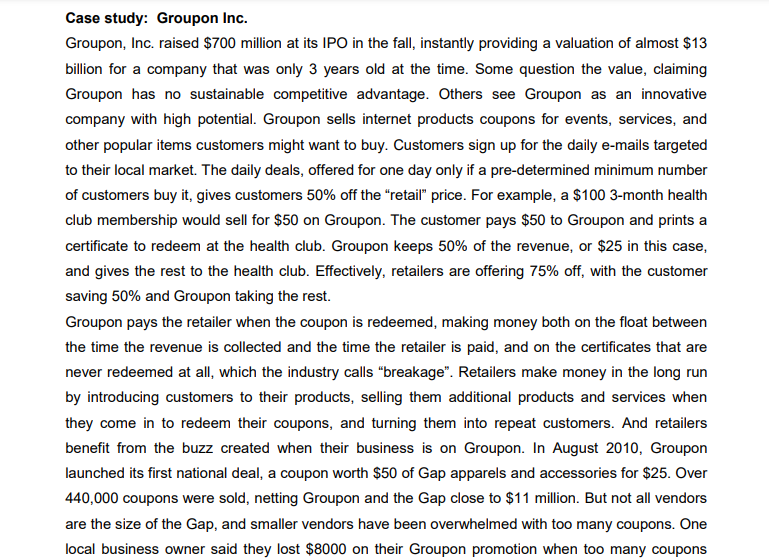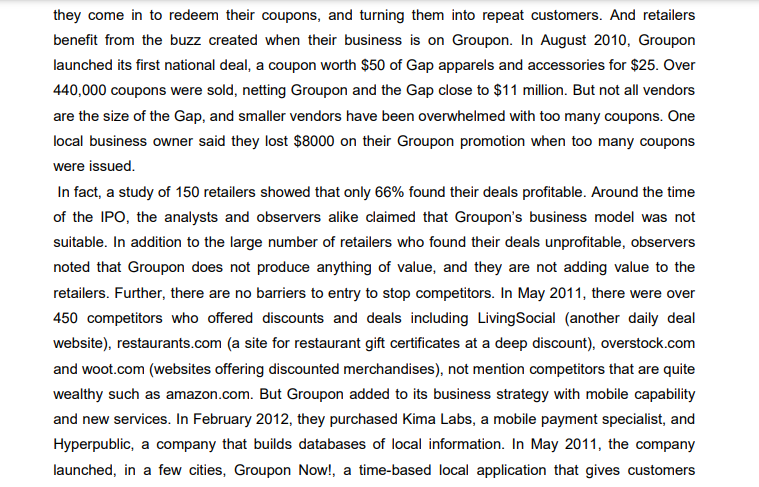



Case study: Groupon Inc. Groupon, Inc. raised $700 million at its IPO in the fall, instantly providing a valuation of almost $13 billion for a company that was only 3 years old at the time. Some question the value, claiming Groupon has no sustainable competitive advantage. Others see Groupon as an innovative company with high potential. Groupon sells internet products coupons for events, services, and other popular items customers might want to buy. Customers sign up for the daily e-mails targeted to their local market. The daily deals, offered for one day only if a pre-determined minimum number of customers buy it, gives customers 50% off the retail" price. For example, a $100 3-month health club membership would sell for $50 on Groupon. The customer pays $50 to Groupon and prints a certificate to redeem at the health club. Groupon keeps 50% of the revenue, or $25 in this case, and gives the rest to the health club. Effectively, retailers are offering 75% off, with the customer saving 50% and Groupon taking the rest. Groupon pays the retailer when the coupon is redeemed, making money both on the float between the time the revenue is collected and the time the retailer is paid, and on the certificates that are never redeemed at all, which the industry calls breakage. Retailers make money in the long run by introducing customers to their products, selling them additional products and services when they come in to redeem their coupons, and turning them into repeat customers. And retailers benefit from the buzz created when their business is on Groupon. In August 2010, Groupon launched its first national deal, a coupon worth $50 of Gap apparels and accessories for $25. Over 440,000 coupons were sold, netting Groupon and the Gap close to $11 million. But not all vendors are the size of the Gap, and smaller vendors have been overwhelmed with too many coupons. One local business owner said they lost $8000 on their Groupon promotion when too many coupons they come in to redeem their coupons, and turning them into repeat customers. And retailers benefit from the buzz created when their business is on Groupon. In August 2010, Groupon launched its first national deal, a coupon worth $50 of Gap apparels and accessories for $25. Over 440,000 coupons were sold, netting Groupon and the Gap close to $11 million. But not all vendors are the size of the Gap, and smaller vendors have been overwhelmed with too many coupons. One local business owner said they lost $8000 on their Groupon promotion when too many coupons were issued. In fact, a study of 150 retailers showed that only 66% found their deals profitable. Around the time of the IPO, the analysts and observers alike claimed that Groupon's business model was not suitable. In addition to the large number of retailers who found their deals unprofitable, observers noted that Groupon does not produce anything of value, and they are not adding value to the retailers. Further, there are no barriers to entry to stop competitors. In May 2011, there were over 450 competitors who offered discounts and deals including Living Social (another daily deal website), restaurants.com (a site for restaurant gift certificates at a deep discount), overstock.com and woot.com (websites offering discounted merchandises), not mention competitors that are quite wealthy such as amazon.com. But Groupon added to its business strategy with mobile capability and new services. In February 2012, they purchased Kima Labs, a mobile payment specialist, and Hyperpublic, a company that builds databases of local information. In May 2011, the company launched, in a few cities, Groupon Now!, a time-based local application that gives customers instant deals at merchants nearby using location-based software. CEO Andrew Mason told Wall Street analysts in February 2012 that he saw significant growth potential, including working on new features that will help customers personalize offers and avoid deals they don't want. The Groupon Now app would allow Groupon Inc to sell internet products coupons for events, services, and other popular items customers might want to buy, based on Local market. Customers will sign up for the daily e-mails targeted to their local market. Once the customer has decided to purchase a groupon ticket, they would then pay online for the ticket and redeem the groupon at the supplier. QUESTION SIX Business analyst should know various analysis techniques to show the flow of information in the company. Explain any FIVE analysis techniques, specifically outlining how they would facilitate your analysis process as a business analyst in Groupon Inc. (1 point a technique, 1 point an explanation WHY, supported with an example from the case study)










